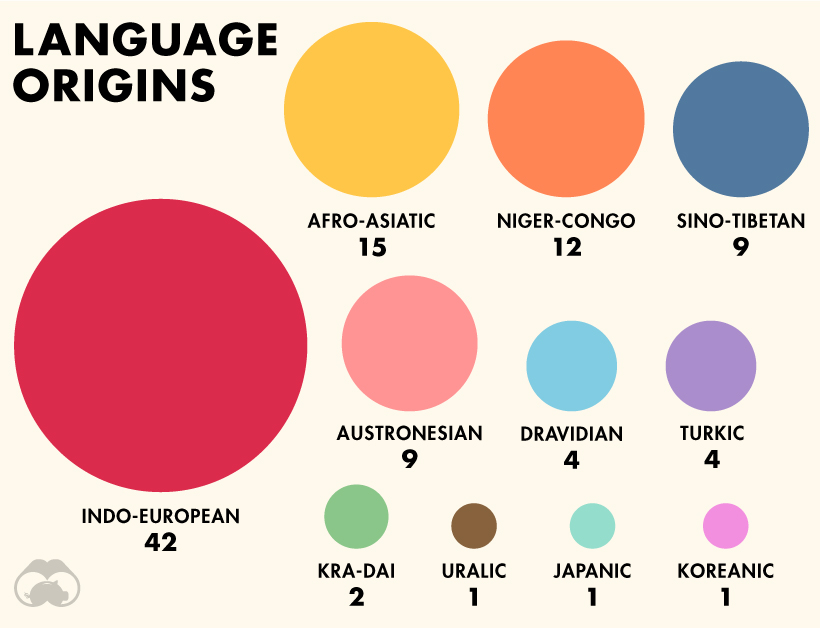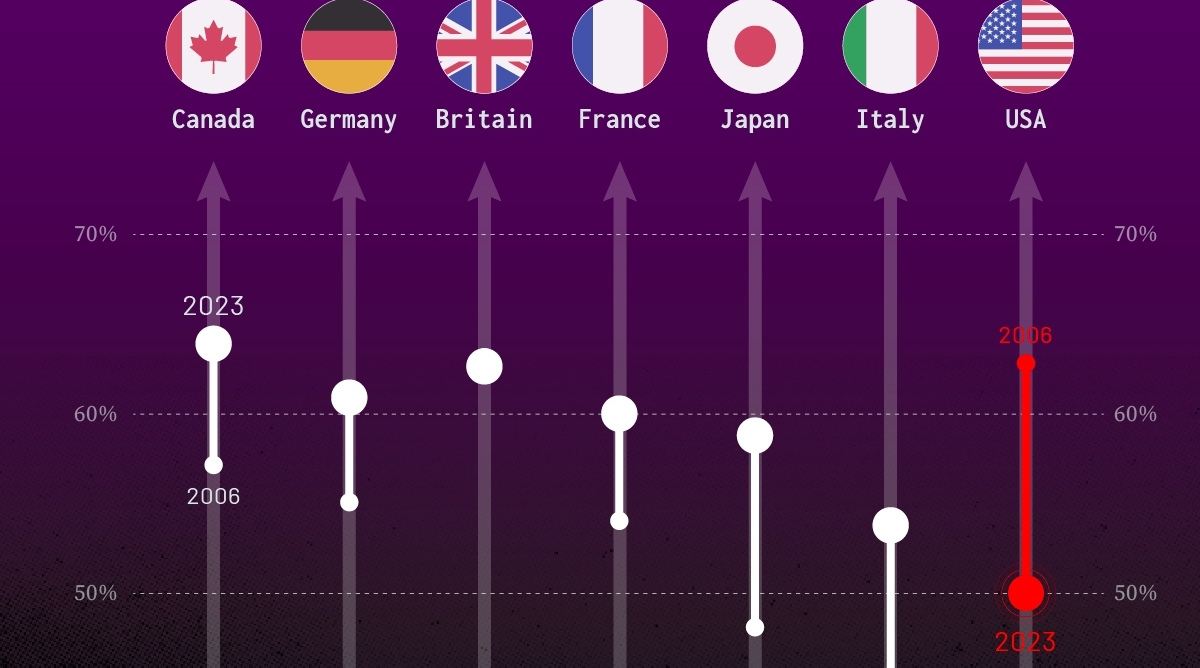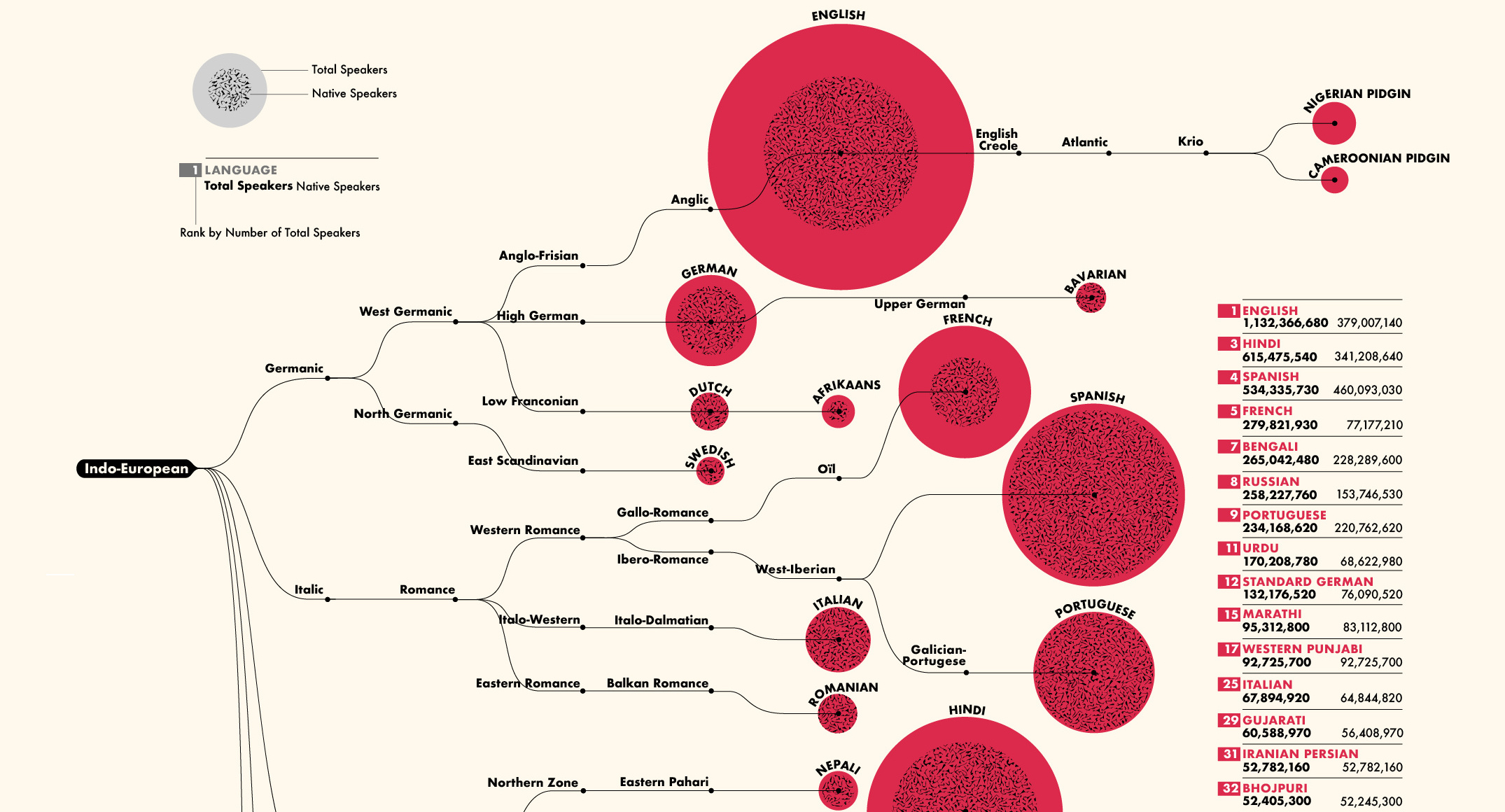Misc
Ranked: The 100 Most Spoken Languages Around the World

Ranked: The 100 Most Spoken Languages Worldwide
Even though you’re reading this article in English, there’s a good chance it might not be your mother tongue. Of the billion-strong English speakers in the world, only 33% consider it their native language.
The popularity of a language depends greatly on utility and geographic location. Additionally, how we measure the spread of world languages can vary greatly depending on whether you look at total speakers or native speakers.
Today’s detailed visualization from WordTips illustrates the 100 most spoken languages in the world, the number of native speakers for each language, and the origin tree that each language has branched out from.
How Do You Define A Language?
The data comes from the 22nd edition of Ethnologue, a database covering a majority of the world’s population, detailing approximately 7,111 living languages in existence today.
The definitions of languages are often dynamic, blurring the lines around a singular understanding of what makes a language:
- Linguistic: focused on lexical and grammatical differences, or on variations within speech communities
- Social: focused on cultural or political factors, as well as heritage and identity
For the purposes of measurement, the researchers use the ISO 693-3 set of criteria, which accounts for related varieties and dialects—ensuring that linguistics are not the only factor considered in this count of languages.
Here are the language origins of the 100 most spoken languages:

Indo-European languages have the widest spread worldwide. According to Ethnologue, the language family contains over 3 billion speakers in total. Interestingly, there are actually 1,526 Niger-Congo languages altogether, though only 12 are represented here.
Let’s now dive into the top 10 most spoken languages overall.
Which Languages Have the Most Speakers?
It comes as no surprise that English reigns supreme, with over 1.1 billion total speakers—or roughly 15% of the global population. Mandarin Chinese, Hindi, Spanish, and French round out the top five.
| Rank | Language | Total Speakers | Language Origin |
|---|---|---|---|
| 1 | English | 1,132 million | Indo-European |
| 2 | Mandarin Chinese | 1,117 million | Sino-Tibetan |
| 3 | Hindi | 615 million | Indo-European |
| 4 | Spanish | 534 million | Indo-European |
| 5 | French | 280 million | Indo-European |
| 6 | Standard Arabic | 274 million | Afro-Asiatic |
| 7 | Bengali | 265 million | Indo-European |
| 8 | Russian | 258 million | Indo-European |
| 9 | Portuguese | 234 million | Indo-European |
| 10 | Indonesian | 199 million | Austronesian |
However, this is only one piece in the full fabric of languages.
The metrics for native speakers tell a slightly different tale, as Mandarin Chinese shoots up to 918 million—almost 2.5x that of English native speakers.
| Rank | Language | Native Speakers | Language Origin |
|---|---|---|---|
| 1 | Mandarin Chinese | 918 million | Sino-Tibetan |
| 2 | Spanish | 460 million | Indo-European |
| 3 | English | 379 million | Indo-European |
| 4 | Hindi | 341 million | Indo-European |
| 5 | Bengali | 228 million | Indo-European |
| 6 | Portuguese | 221 million | Indo-European |
| 7 | Russian | 154 million | Indo-European |
| 8 | Japanese | 128 million | Japanic |
| 9 | Western Punjabi | 93 million | Indo-European |
| 10 | Marathi | 83 million | Indo-European |
Note: No native speaker data was available for Filipino, Standard Arabic, Nigerian Pidgin, or Cameroonian Pidgin.
Here, Spanish comes in strong second for native speakers with 460 million, considering it’s well-used across Latin America. The Indian languages of Hindi and Bengali cap off the top five by native speakers as well.
These are the biggest languages people learn growing up, but what about the ones they pick up later in life?
What About Second (L2) Languages?
Nearly 43% of the world’s population is bilingual, with the ability to switch between two languages with ease.
From the data, second language (L2) speakers can be calculated by looking at the difference between native and total speakers, as a proportion of the total. For example, 66% of English speakers learned it as a second language.
Swahili surprisingly has the highest ratio of L2 speakers to total speakers—although it only has 16 million native speakers, this shoots up to 98 million total speakers. Overall, 82% of Swahili speakers know it as a second language.
Swahili is listed as a national or official language in several African countries: Tanzania, Kenya, Uganda, and the Democratic Republic of Congo. It’s likely that the movement of people from rural areas into big cities in search of better economic opportunities, is what’s boosting the adoption of Swahili as a second language.
Indonesian is another similar example. With a 78% proportion of L2 speakers compared to total speakers, this variation on the Malay language has been used as the lingua franca across the islands for a long time. In contrast, only 17% of Mandarin speakers know it as a second language, perhaps because it is one of the most challenging languages to learn.
Keeping Language Traditions Alive
Languages are fluid, and constantly evolving—altogether, the 100 most spoken languages paint a unique picture across centuries of a changing world. Here’s the full list of these languages, by types of speakers and language origin.
| Rank | Language | Total Speakers | Native Speakers | Origin |
|---|---|---|---|---|
| 1 | English | 1,132M | 379M | Indo-European |
| 2 | Mandarin Chinese | 1,117M | 918M | Sino-Tibetan |
| 3 | Hindi | 615M | 341M | Indo-European |
| 4 | Spanish | 534M | 460M | Indo-European |
| 5 | French | 280M | 77M | Indo-European |
| 6 | Standard Arabic | 274M | NA | Afro-Asiatic |
| 7 | Bengali | 265M | 228M | Indo-European |
| 8 | Russian | 258M | 154M | Indo-European |
| 9 | Portuguese | 234M | 221M | Indo-European |
| 10 | Indonesian | 199M | 43M | Austronesian |
| 11 | Urdu | 170M | 69M | Indo-European |
| 12 | Standard German | 132M | 76M | Indo-European |
| 13 | Japanese | 128M | 128M | Japanic |
| 14 | Swahili | 98M | 16M | Niger-Congo |
| 15 | Marathi | 95M | 83M | Indo-European |
| 16 | Telugu | 93M | 82M | Dravidian |
| 17 | Western Punjabi | 93M | 93M | Indo-European |
| 18 | Wu Chinese | 82M | 81M | Sino-Tibetan |
| 19 | Tamil | 81M | 75M | Dravidian |
| 20 | Turkish | 80M | 69M | Turkic |
| 21 | Korean | 77M | 77M | Koreanic |
| 22 | Vietnamese | 77M | 76M | Austronesian |
| 23 | Yue Chinese | 74M | 73M | Sino-Tibetan |
| 24 | Javanese | 68M | 68M | Austronesian |
| 25 | Italian | 68M | 65M | Indo-European |
| 26 | Egyptian Spoken Arabic | 65M | 65M | Afro-Asiatic |
| 27 | Hausa | 63M | 44M | Afro-Asiatic |
| 28 | Thai | 61M | 21M | Kra-Dai |
| 29 | Gujarati | 61M | 56M | Indo-European |
| 30 | Kannada | 56M | 44M | Dravidian |
| 31 | Iranian Persian | 53M | 53M | Indo-European |
| 32 | Bhojpuri | 52M | 52M | Indo-European |
| 33 | Southern Min Chinese | 50M | 50M | Sino-Tibetan |
| 34 | Hakka Chinese | 48M | 48M | Sino-Tibetan |
| 35 | Jinyu Chinese | 47M | 47M | Sino-Tibetan |
| 36 | Filipino | 45M | NA | Austronesian |
| 37 | Burmese | 43M | 33M | Sino-Tibetan |
| 38 | Polish | 40M | 40M | Indo-European |
| 39 | Yoruba | 40M | 38M | Niger-Congo |
| 40 | Odia | 38M | 34M | Indo-European |
| 41 | Malayalam | 38M | 37M | Dravidian |
| 42 | Xiang Chinese | 37M | 37M | Sino-Tibetan |
| 43 | Maithili | 34M | 34M | Indo-European |
| 44 | Ukrainian | 33M | 27M | Indo-European |
| 45 | Moroccan Spoken Arabic | 33M | 27M | Afro-Asiatic |
| 46 | Eastern Punjabi | 33M | 33M | Indo-European |
| 47 | Sunda | 32M | 32M | Austronesian |
| 48 | Algerian Spoken Arabic | 32M | 29M | Afro-Asiatic |
| 49 | Sudanese Spoken Arabic | 32M | 32M | Afro-Asiatic |
| 50 | Nigerian Pidgin | 30M | NA | Indo-European |
| 51 | Zulu | 28M | 12M | Niger-Congo |
| 52 | Igbo | 27M | 27M | Niger-Congo |
| 53 | Amharic | 26M | 22M | Afro-Asiatic |
| 54 | Northern Uzbek | 25M | 25M | Turkic |
| 55 | Sindhi | 25M | 25M | Indo-European |
| 56 | North Levantine Spoken Arabic | 25M | 25M | Afro-Asiatic |
| 57 | Nepali | 25M | 16M | Indo-European |
| 58 | Romanian | 24M | 24M | Indo-European |
| 59 | Tagalog | 24M | 24M | Austronesian |
| 60 | Dutch | 23M | 23M | Indo-European |
| 61 | Sa'idi Spoken Arabic | 22M | 22M | Afro-Asiatic |
| 62 | Gan Chinese | 22M | 22M | Sino-Tibetan |
| 63 | Northern Pashto | 21M | 21M | Indo-European |
| 64 | Magahi | 21M | 21M | Indo-European |
| 65 | Saraiki | 20M | 20M | Indo-European |
| 66 | Xhosa | 19M | 8M | Niger-Congo |
| 67 | Malay | 19M | 16M | Austronesian |
| 68 | Khmer | 18M | 17M | Austronesian |
| 69 | Afrikaans | 18M | 7M | Indo-European |
| 70 | Sinhala | 17M | 15M | Indo-European |
| 71 | Somali | 16M | 16M | Afro-Asiatic |
| 72 | Chhattisgarhi | 16M | 16M | Indo-European |
| 73 | Cebuano | 16M | 16M | Austronesian |
| 74 | Mesopotamian Spoken Arabic | 16M | 16M | Afro-Asiatic |
| 75 | Assamese | 15M | 15M | Indo-European |
| 76 | Northeastern Thai | 15M | 15M | Kra-Dai |
| 77 | Northern Kurdish | 15M | 15M | Indo-European |
| 78 | Hijazi Spoken Arabic | 15M | 15M | Afro-Asiatic |
| 79 | Nigerian Fulfulde | 14M | 14M | Niger-Congo |
| 80 | Bavarian | 14M | 14M | Indo-European |
| 81 | Bamanankan | 14M | 4M | Niger-Congo |
| 82 | South Azerbaijani | 14M | 14M | Turkic |
| 83 | Northern Sotho | 14M | 5M | Niger-Congo |
| 84 | Setswana | 14M | 6M | Niger-Congo |
| 85 | Souther Sotho | 14M | 6M | Niger-Congo |
| 86 | Czech | 13M | 11M | Indo-European |
| 87 | Greek | 13M | 13M | Indo-European |
| 88 | Chittagonian | 13M | 13M | Indo-European |
| 89 | Kazakh | 13M | 13M | Turkic |
| 90 | Swedish | 13M | 10M | Indo-European |
| 91 | Deccan | 13M | 13M | Indo-European |
| 92 | Hungarian | 13M | 13M | Uralic |
| 93 | Jula | 12M | 2M | Niger-Congo |
| 94 | Sadri | 12M | 5M | Indo-European |
| 95 | Kinyarwanda | 12M | 12M | Niger-Congo |
| 96 | Cameroonian Pidgin | 12M | NA | Indo-European |
| 97 | Sylheti | 12M | 10M | Indo-European |
| 98 | South Levantine Spoken Arabic | 12M | 12M | Afro-Asiatic |
| 99 | Tunisian Spoken Arabic | 12M | 12M | Afro-Asiatic |
| 100 | Sanaani Spoken Arabic | 11M | 11M | Afro-Asiatic |
One reason these languages are popular is that they are actively and consistently used. Unfortunately, nearly 3,000 (about 40%) of all languages are at risk of being lost, or are already in the process of dying out today.
Languages play a crucial role in our daily lives. … [Their] losses have huge negative impacts indigenous peoples’ most basic human rights.
—UN, IYoIL statement
As a result, the United Nations declared 2019 the International Year of Indigenous Languages (IYoIL), with a resolution to continue fostering these languages and pass on their knowledge for future generations.
Politics
Charted: Trust in Government Institutions by G7 Countries
How much do you trust the government and its various institutions? We look at data for G7 countries for the time period of 2006-2023.

Trust in Government Institutions by G7 Countries
This was originally posted on our Voronoi app. Download the app for free on iOS or Android and discover incredible data-driven charts from a variety of trusted sources.
How much do you trust the government, and its various institutions?
It’s likely that your level of confidence probably depends on a wide range of factors, such as perceived competency, historical context, economic performance, accountability, social cohesion, and transparency.
And for these same reasons, trust levels in government institutions also change all the time, even in the world’s most developed countries: the G7.
Confidence in Government by G7 Countries (2006-2023)
This chart looks at the changes in trust in government institutions between the years 2006 and 2023, based on data from a multi-country Gallup poll.
Specifically, this dataset aggregates confidence in multiple national institutions, including the military, the judicial system, the national government, and the integrity of the electoral system.
| Country | Confidence (2006) | Confidence (2023) | Change (p.p.) |
|---|---|---|---|
| Canada | 57% | 64% | +7 |
| Britain | 63% | 63% | +0 |
| Germany | 55% | 61% | +6 |
| France | 54% | 60% | +6 |
| Japan | 48% | 59% | +11 |
| Italy | 41% | 54% | +13 |
| United States | 63% | 50% | -13 |
What’s interesting here is that in the G7, a group of the world’s most developed economies, there is only one country bucking the general trend: the United States.
Across most G7 countries, confidence in institutions has either improved or stayed the same between 2006 and 2023. The largest percentage point (p.p.) increases occur in Italy and Japan, which saw +13 p.p. and +11 p.p. increases in trust over the time period.
In the U.S., however, confidence in government institutions has fallen by 13 p.p. over the years. What happened?
Key Figures on U.S. Trust in Institutions
In 2006, the U.S. was tied with the UK as having the highest confidence in government institutions, at 63%.
But here’s where the scores stand in 2023, across various institutions:
| 🇺🇸 Institutions | Confidence (2023) |
|---|---|
| Military | 81% |
| Judiciary | 42% |
| National Government | 30% |
| Elections | 44% |
| Overall | 49% |
Based on this data, it’s clear that the U.S. lags behind in three key indicators: confidence in the national government, confidence in the justice system, and confidence in fair elections. It ranked in last place for each indicator in the G7.
One other data point that stands out: despite leading the world in military spending, the U.S. is only the third most confident in its military in the G7. It lags behind France (86%) and the United Kingdom (83%).
-

 Wealth6 days ago
Wealth6 days agoCharted: Which City Has the Most Billionaires in 2024?
-

 Mining2 weeks ago
Mining2 weeks agoGold vs. S&P 500: Which Has Grown More Over Five Years?
-

 Uranium2 weeks ago
Uranium2 weeks agoThe World’s Biggest Nuclear Energy Producers
-

 Education2 weeks ago
Education2 weeks agoHow Hard Is It to Get Into an Ivy League School?
-

 Debt2 weeks ago
Debt2 weeks agoHow Debt-to-GDP Ratios Have Changed Since 2000
-

 Sports2 weeks ago
Sports2 weeks agoThe Highest Earning Athletes in Seven Professional Sports
-

 Science2 weeks ago
Science2 weeks agoVisualizing the Average Lifespans of Mammals
-

 Brands1 week ago
Brands1 week agoHow Tech Logos Have Evolved Over Time















